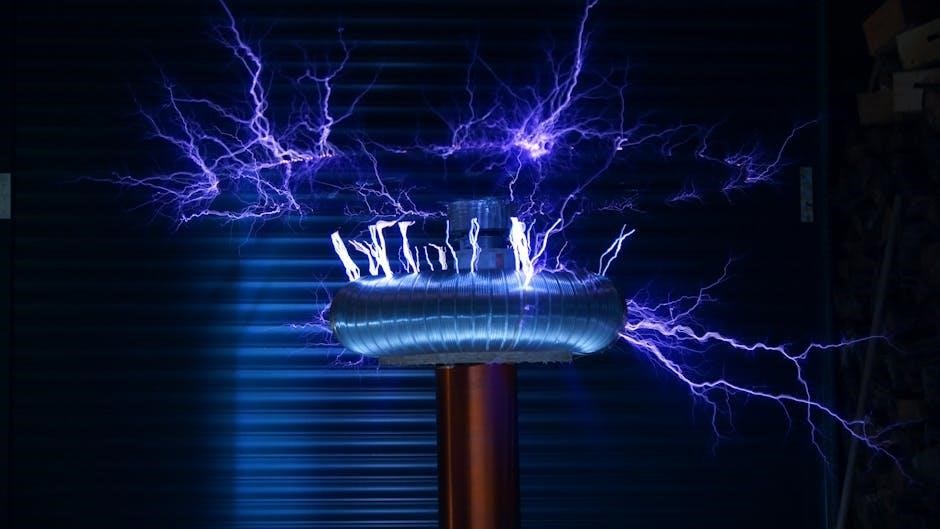The 2014 National Electrical Code (NEC), published by the NFPA, sets standards for electrical safety in design, installation, and inspection. It is widely adopted by states and forms the basis of local electrical codes, ensuring protection for people and property. The NEC is updated periodically to reflect advancements in technology and safety practices, making it a critical resource for electricians, contractors, and enforcement agencies.
Overview of the NEC and Its Importance
The National Electrical Code (NEC) serves as the foundational standard for electrical safety in the United States. Published by the National Fire Protection Association (NFPA), it provides comprehensive guidelines for the design, installation, and inspection of electrical systems. The NEC is crucial for ensuring the safety of people, property, and the environment by mitigating fire and electrical hazards. Its principles are universally adopted across jurisdictions, with local amendments, making it a unified benchmark for the electrical industry. Electricians, contractors, and enforcement agencies rely on the NEC to comply with legal requirements and best practices, ensuring reliable and secure electrical systems nationwide.
Key Updates in the 2014 Edition
The 2014 NEC introduced significant updates to enhance electrical safety and adapt to evolving technologies. One major change was the requirement for GFCI protection in laundry areas to reduce shock risks. AFCI requirements were expanded to include additional areas in residential buildings to prevent arcing faults. The code also addressed emerging technologies like photovoltaic systems and electric vehicle charging. New provisions for wiring methods and materials were added to improve safety and efficiency. Additionally, the 2014 edition clarified requirements for hazardous locations and updated standards for electrical equipment in various environments. These updates reflect the NEC’s commitment to advancing safety and accommodating modern electrical demands.

Major Changes in the 2014 NEC
The 2014 NEC introduced significant updates, including expanded GFCI requirements, revised AFCI standards, and enhanced safety measures for electrical systems in hazardous locations and laundry areas.
New Requirements for Ground Fault Circuit Interrupters (GFCIs)
The 2014 NEC mandates GFCI protection for all 125V, 15A, or 20A receptacles in laundry areas, enhancing safety in environments prone to moisture. This change addresses increased risk of electrical shock, ensuring better protection for users. Additionally, GFCIs are now required in areas where equipment or people are exposed to water, such as outdoor spaces and areas near sinks. This update aligns with broader safety goals, reducing hazards in both residential and commercial settings. Compliance with these requirements is essential for ensuring electrical systems meet modern safety standards.
Revisions in Arc Fault Circuit Interrupter (AFCI) Requirements
The 2014 NEC introduced revisions to AFCI requirements, expanding their application to include additional areas and circuits. AFCIs are now mandated in branch circuits supplying outlets in dormitories, guest rooms, and common areas of hotels, as well as in certain residential and commercial spaces. These changes aim to reduce the risk of arc faults, which can lead to fires. The updated requirements ensure broader protection by covering more types of electrical circuits and living spaces, reflecting advancements in fire prevention technology and safety standards. Compliance with these revisions is crucial for maintaining electrical safety in various environments.
Safety Enhancements in the 2014 NEC
The 2014 NEC introduced significant safety enhancements, including expanded GFCI requirements for laundry areas and improved protection for circuits in hazardous locations, reducing fire and shock risks.
Improved Protection for Electrical Receptacles in Laundry Areas
The 2014 NEC introduced a new requirement for Ground Fault Circuit Interrupter (GFCI) protection in laundry areas. Section 210.8(A)(10) mandates GFCI protection for all 125V, 15A or 20A receptacles in these spaces. This update addresses the heightened risk of electrical shock in areas where moisture and water are present, such as near washing machines or sinks. By requiring GFCI protection, the NEC enhances safety by interrupting dangerous ground faults, reducing the likelihood of shock or fire. This change reflects the NEC’s commitment to adapting safety standards to evolving household conditions, ensuring greater protection for residents and property.
Enhanced Safety Measures for Electrical Systems in Hazardous Locations
The 2014 NEC introduced enhanced safety measures for electrical systems in hazardous locations to mitigate risks of explosions and fires. These updates include stricter requirements for explosion-proof equipment, improved sealing methods, and updated testing protocols. New provisions ensure that electrical systems in areas with flammable gases, vapors, or dust are designed and installed to prevent ignition sources. Additionally, the code now mandates more rigorous inspection and maintenance protocols for equipment in hazardous environments. These changes reflect a commitment to protecting people and property in high-risk areas, aligning with global safety standards and addressing evolving industrial and environmental challenges.

Accessing the 2014 NEC PDF
The 2014 NEC PDF can be accessed through official NFPA sources or authorized distributors. Ensure compliance with security features and access requirements for legal usage.
Official Sources for Downloading the 2014 NEC PDF
The 2014 NEC PDF is available for download through the official NFPA website and authorized distributors. Users can access the document by selecting the edition year and accepting the terms and conditions. Additionally, some jurisdictions provide free access to the NEC through their official portals. It is essential to ensure that the PDF is obtained from reputable sources to avoid unauthorized versions. The NFPA also offers a free access option for registered users, which can be found by navigating to the specific publication page and following the prompts. Always verify the source to maintain compliance with copyright and usage regulations.
Understanding Security Features and Access Requirements
The 2014 NEC PDF incorporates advanced security features to protect intellectual property and ensure compliance with copyright laws. These include digital rights management (DRM) and encryption to prevent unauthorized copying or sharing. Access typically requires registration on the NFPA website or through authorized distributors. Users may need to accept terms and conditions before viewing the document. Some versions are restricted to a single device, while others allow limited printing and sharing. Security plugins may be required for certain editions. Compliance with these measures is crucial to avoid legal issues and ensure uninterrupted access to the publication.

Implementation and Enforcement
The 2014 NEC is enforced through state and local jurisdictions, ensuring compliance with safety standards. Regular inspections verify adherence to code requirements, maintaining electrical safety and reducing risks.
State and Local Adoption of the 2014 NEC
The adoption of the 2014 NEC varies by state and local jurisdictions, with many enforcing it as part of their electrical codes. States like Alabama, Colorado, Connecticut, and Florida have incorporated the NEC into their regulations, often with local amendments. Jurisdictions may modify the code to address regional safety concerns or specific hazards. For example, Massachusetts has adopted the NEC through its regulatory framework, ensuring compliance with updated safety standards. This process highlights the NEC’s role as a foundational document, adapted to meet the needs of different regions while maintaining a focus on electrical safety and consistency across the U.S.
Compliance and Inspection Requirements
Compliance with the 2014 NEC is enforced through mandatory inspections by certified officials, ensuring electrical systems meet safety standards. Installations must adhere to code requirements, and inspections are conducted to verify conformity. Authorities review wiring, circuits, and equipment to prevent hazards and ensure proper functionality. Documentation, such as installation certificates, may be required for compliance verification. Regular testing of safety devices, like GFCIs, is also mandated to maintain electrical safety. Non-compliance can result in penalties or system shutdowns until deficiencies are corrected. These measures ensure public safety and uphold the integrity of electrical systems across residential and commercial applications.
Training and Resources

Training and Resources
Guides, manuals, and online courses provide comprehensive training on the 2014 NEC, ensuring electricians understand and apply the code effectively for safe electrical installations and inspections.
Guides and Manuals for Understanding the 2014 NEC
Guides and manuals, such as Mike Holt’s index and the NEC Handbook, provide in-depth explanations of the 2014 NEC. These resources are designed to help electricians, contractors, and inspectors navigate the code’s complex requirements. They offer detailed commentary, diagrams, and practical examples to clarify ambiguous sections. Additionally, these materials include cross-references to related code articles, making it easier to understand and apply the regulations. Manuals often cover topics like grounding, wiring methods, and safety protocols, ensuring compliance with the latest standards. They are invaluable tools for professionals seeking to master the 2014 NEC and ensure safe, code-compliant electrical installations.
Online Courses and Workshops for Electricians
Online courses and workshops are essential for electricians to stay updated on the 2014 NEC requirements. These programs, offered by platforms like EC&M and Mike Holt, provide in-depth training on code changes, safety protocols, and practical applications. They cover topics such as GFCI installation, AFCI requirements, and hazard location safety. Many courses are designed for both new and experienced professionals, offering flexible learning options. These resources ensure electricians can apply the latest standards effectively, maintaining compliance and enhancing workplace safety; Regular participation in such training helps professionals stay current with evolving electrical codes and technologies.
